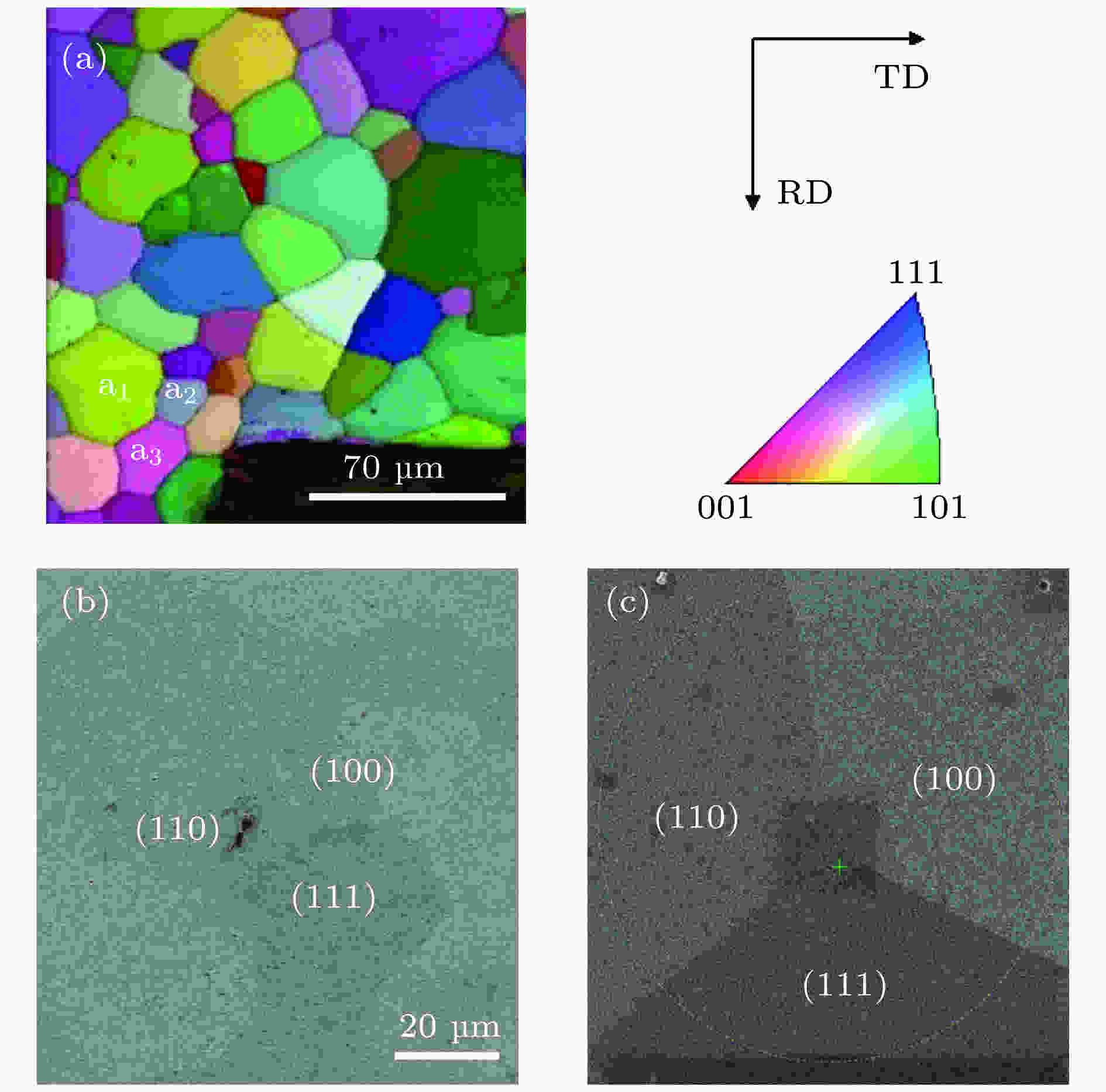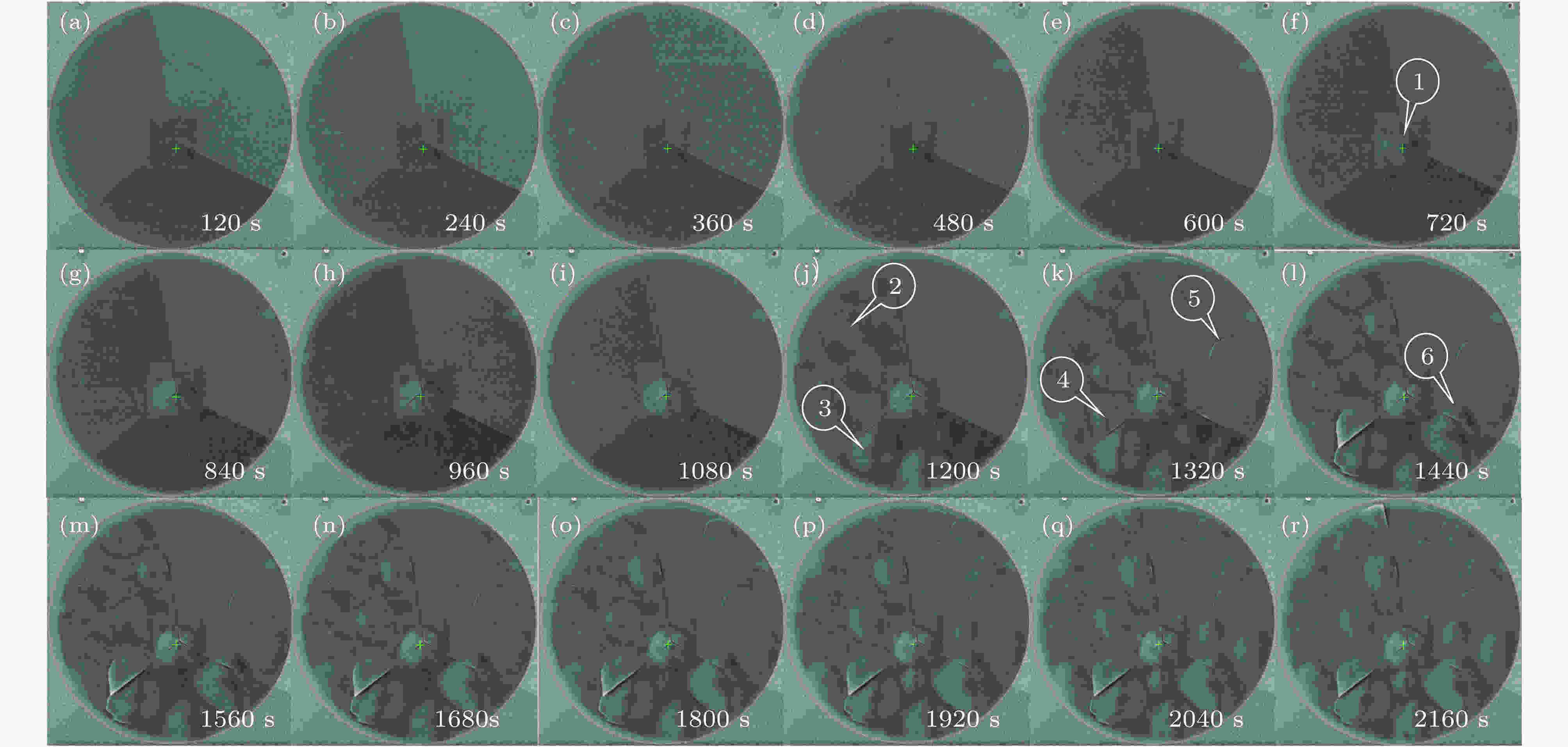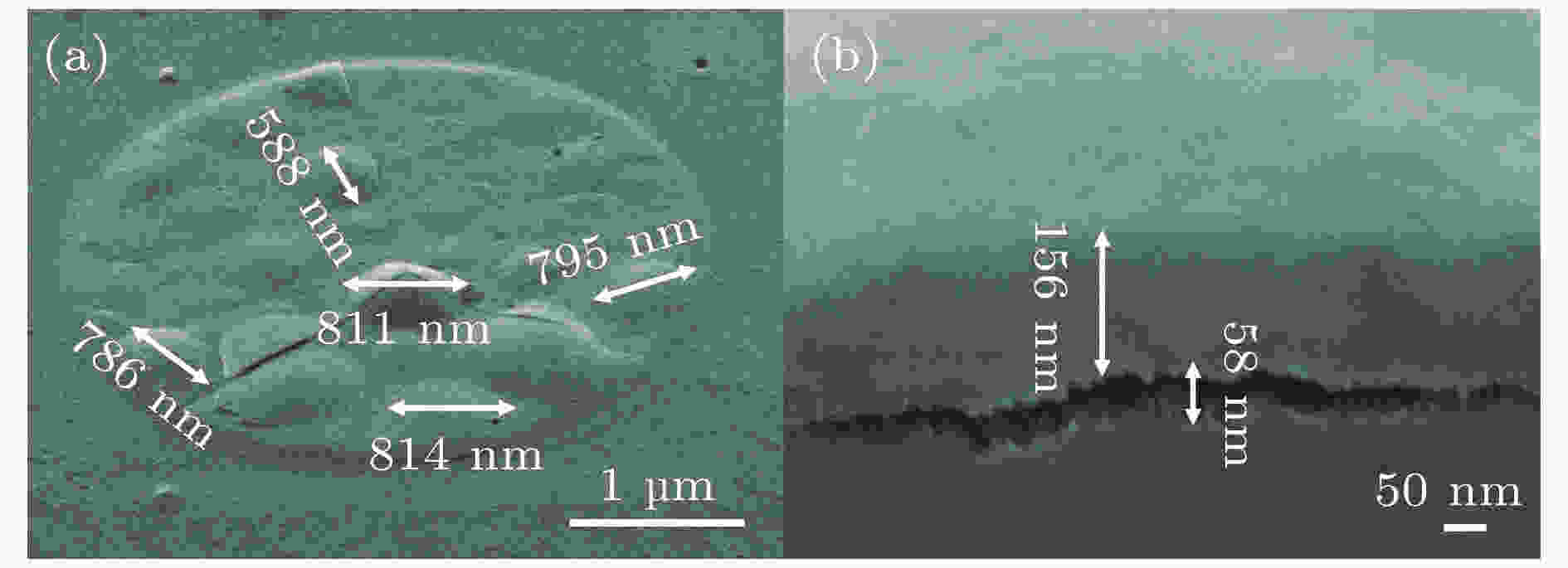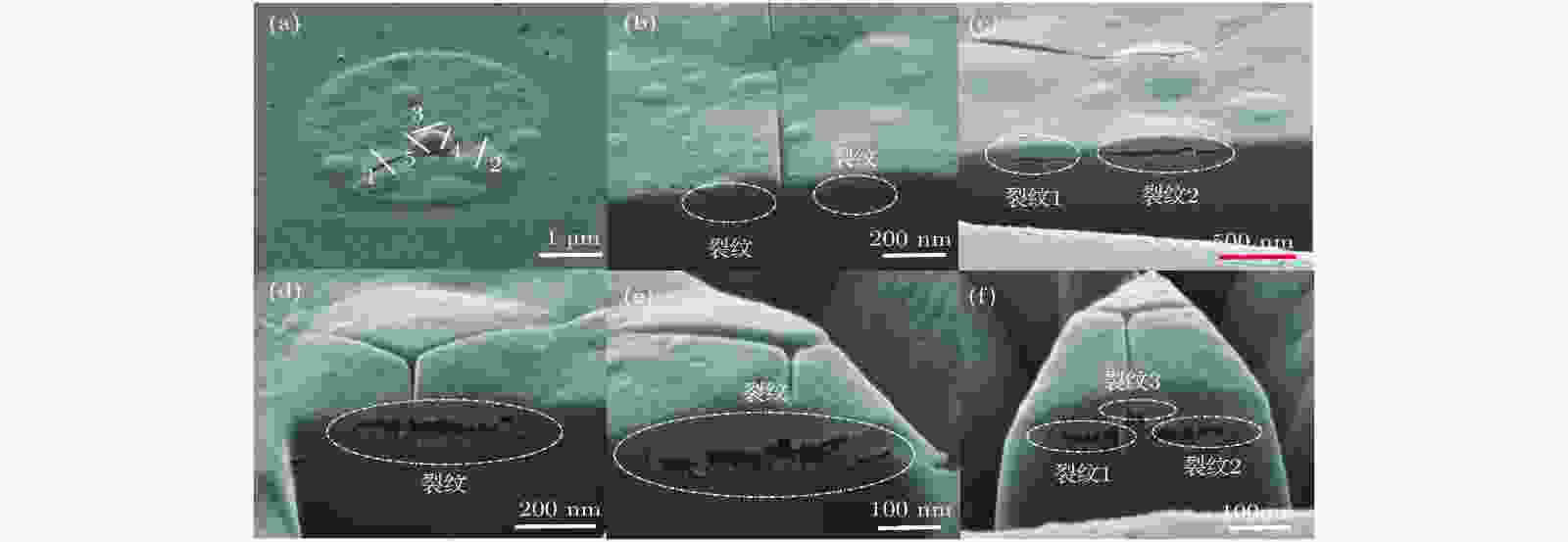全文HTML
--> --> -->W中He行为的研究主要通过两种途径, 一是托卡马克装置实验, 在国际热核聚变堆(international thermonuclear experimental reactor, ITER)运行的实际环境下研究等离子体与壁材料的复杂综合相互作用; 二是实验模拟, 主要的实验模拟装置有直线等离子体发生装置和离子注入机等, 在模拟ITER运行环境中单一或者简单综合条件下研究等离子体与壁材料的相互作用. 但是, 现有托卡马克以验证聚变反应高效运行为主, 时间和成本上难以兼顾材料测试研究. 而实验室规模上的实验模拟和数值模拟相结合, 为聚变堆材料的研发和测试提供了低成本、高效率、条件灵活的实验平台, 已成为聚变堆材料研究与测试不可或缺的研究手段. 目前大多数实验模拟采用加速器和离子注入机来进行实验模拟, 这类设备提供的束流一般在<1018 ions/m2·s以下, 由于ITER热核聚变堆中等离子体的束流一般在1018 ions/m2·s以上, 能量在1 eV到几十keV, 加速器和离子注入机无法模拟ITER热核聚变堆大束流稳定运行的实际环境. 利用上述实验设备, W中He行为的研究主要进行了在不同能量(eV—MeV)、不同温度(300—2600 K)、不同剂量(1020—1027 ions/m2)条件下的一系列的辐照实验研究[4], 并得到离子的能量、注入剂量、剂量率、靶的温度以及晶体取向都会影响W中He行为, He辐照下W中产生各种类型的缺陷, 如间隙原子、空位、位错环、空洞、He泡、“fuzz”等[5-9]. 扫描电子显微镜(scanning electron microscope, SEM)和透射电子显微镜(transmission electron microscope, TEM)是He辐照后诱发的W近表面微观结构及性能变化的主要研究手段, 用来直接观测He泡的形态大小、密度、分布以及其形成机理的分析. 采用该研究手段结合计算模拟方法得出了He辐照下W表面起泡行为的规律和机理的主流观点: He注入钨中后被其诱发的缺陷捕获, 导致He在缺陷处的大量聚集, 形成过饱和状态, 从而形成一定的局域应力, 当局域应力过大时材料会发生相应的塑性变形, 进而形成He泡, 孔洞等辐照损伤[10-12]. 但是由于不同辐照缺陷和He之间的相关作用十分复杂, 现在对于He注入下W表面起泡行为的规律和机理并没有完全一致的理论. 目前研究设备、手段以及方法还不能直接观测到He泡的形成及演化, 而且TEM由于其透射样品的体积不会超过1 mm3, 其统计性存在局限性, 因此, 亟待新研究手段和方法用来研究W中微观He行为, 以期弄清W中He行为的规律及其机理.
本工作首先介绍氦离子显微镜(helium ion microscope, HIM)的工作原理和独特性能; 其次在HIM上进行W中He的注入, 并借助HIM对注入过程中W的表面形貌的变化进行监测; 最后借助HIM对W中He注入诱发的表面和近表面的微观损伤进行原位在线分析, 期望HIM有助于进一步对W中微观He行为的认识.
2.1.工作原理
HIM的组成部件与SEM很类似, HIM的整体结构如图1所示, 主要由离子光学系统、信号收集及显示系统、真空系统和电源系统[13]. 离子光学系统是由离子源、电磁透镜、扫描线圈和样品室等部件组成, 其作用是用来获得扫描离子束, 作为信号的激发源. 为了获得较高的信号强度和图像分辨率, 扫描离子束应具有较高的亮度和尽可能小的束斑直径, 这是与SEM电子光学系统不同之处. 信号收集系统由电子探测器和离子探测器组成, 检测样品在入射离子作用下产生的二次电子信号和被散射离子信号, 然后经视频放大作为显像系统的调制信号. 真空系统的作用是为保证离子光学系统正常工作, 一般情况下要求保持10–8 Pa的真空度. 电源系统由稳压, 稳流及相应的安全保护电路所组成, 其作用是提供HIM各部分所需的电源. 图 1 HIM整体结构及其工作原理图 (a)整体结构; (b)工作原理
图 1 HIM整体结构及其工作原理图 (a)整体结构; (b)工作原理Figure1. Schematic diagram and working principle diagram of HIM: (a) Schematic diagram; (b) working principle diagram.
HIM是在场离子显微镜(field ion microscope, FIM)基础上发展起来, 以曲率10—100 nm的单晶钨作针尖, 以氦(He)(或氢(H)、或氖(Ne)和氩(Ar)等惰性气体)为成像气体, 其工作原理如图1 所示[13]. 具体为: 液氮冷却的单晶钨丝针尖, 被放置在几百Pa低压的氦气氛围内; 氦原子被吸附在冷钨丝上; 钨丝上有一定的高压, 尖端3个钨原子上所吸附的氦原子会被电离激发成离子, 形成3个不同方向的离子束流; 选择其中一束离子束流, 进行加速、聚焦, 用于扫描样品并捕获其二次电子、背散射离子图像, 从而获得样品信息, 同时也实现对样品的刻蚀.
 图 2 W样品的EBSD衍射花样和表面微观形貌 (a)EBSD衍射花样; (b)表面微观形貌; (c)注入区域
图 2 W样品的EBSD衍射花样和表面微观形貌 (a)EBSD衍射花样; (b)表面微观形貌; (c)注入区域Figure2. EBSD map and surface micrograph of tungsten: (a) EBSD map of tungsten; (b) surface micrograph of tungsten; (c) the irradiated area of tungsten.
2
2.2.工作性能
HIM不仅具有SEM的显微成像功能, 还具有聚焦离子束(focused ion beam, FIB)的纳米加工功能和离子注入机(ion implanter)的离子注入功能. HIM可以实现高效、高精度的亚10 nm级结构的加工, 是唯一的集Ga、Ne、He三种离子束为一体的成像加工平台, 覆盖了微米到纳米尺度的成像与加工应用[14,15]. 与SEM、FIB和ion implanter相比, HIM具有以下几个方面的独特性能和优势.1) 超高分辨率显微能力. HIM具有分辨率为 < 0.5 nm 超高分辨率, 比SEM高一个数量级, 理论上有可能达到TEM观察效果.
2) 超高精度的纳米加工能力. HIM具有亚10 nm加工能力, 其精度比FIB高2—5倍, 这种加工能力可以实现材料表面纳米化, 人为地构建出材料表面纳米图形.
3) 低中能大通量的离子注入能力[16]. HIM的加速电压为0.5—35 kV, He离子束流强度为0.1—100 pA, 离子束斑直径为0.5 nm, 由通量公式




4) 实时在线监测和原位分析. HIM在加工和离子注入过程中能够实时在线监测样品表面信息且进行原位分析, 这是SEM、FIB和ion implanter等设备所不具备的独特能力.









He注入过程中样品表面形貌的变化采用HIM进行在线监测. 整个注入的时间为2160 s, 每隔20 s对He注入过程取一幅图进行监测. 为了简化研究, 在此每隔120 s选取一幅图用来分析注入过程中W中He泡形成、演变过程以及其诱导的W表面形貌变化, 如图3所示. 与图2(c)未进行He注入的原始形貌对比, 在720 s时在a1、a2、a3三个晶粒的交界处表面已经起泡, 标识为He泡1, 如图3(f)所示, 而其他区域表面平滑没有起泡. 这主要原因在于三个晶粒的交界处在显微形貌分析中预先注入了He离子, 注入剂量达到了起泡阈值, 从而表面起泡. 除三个晶粒的交界处之外的区域, 在1200 s时, 注入剂量约为5.56 × 1021 ions/m2, 晶体取向接近(110)和(111)的a1和a2晶粒表面已经起少量的泡, 如图3(j)所示, 在两个晶粒表面分别选取了He泡2和He泡3作为单个泡的跟踪研究. 此时晶体取向接近(100)晶粒a3表面平滑, 没有出现起泡现象. 这表明He泡的形成与晶粒取向具有很明显的依赖关系. He泡更容易形成于(111)取向的晶粒a2表面, 而不容易形成于(100)取向的晶粒a3上. 这种晶粒取向依赖关系和文献[17-21]中结果是一致的. 当注入时间增加到1320 s时, 晶粒a3表面出现了He泡, 如图3(k)所示, 而且He泡5破裂. 此后随着注入剂量的增大, 各个晶体取向的晶粒表面出现He泡增大、破裂现象, 如图3(k)—(r)所示. 纵观整个注入过程W表面起泡情况, 样品在注入区域内的起泡程度不均匀, 各个晶体取向的晶粒起泡阈值也不一样.
 图 3 He泡生长过程的原位在线监测 (a) 120 s; (b) 240 s; (c) 360 s; (d) 480 s; (e) 600 s; (f) 720 s; (g) 840 s; (h) 960 s; (i) 1080 s; (j) 1200 s; (k) 1320 s; (l) 1440 s; (m) 1560 s; (n) 1680 s; (o) 1800 s; (p) 1920 s; (q) 2040 s; (r) 2160 s
图 3 He泡生长过程的原位在线监测 (a) 120 s; (b) 240 s; (c) 360 s; (d) 480 s; (e) 600 s; (f) 720 s; (g) 840 s; (h) 960 s; (i) 1080 s; (j) 1200 s; (k) 1320 s; (l) 1440 s; (m) 1560 s; (n) 1680 s; (o) 1800 s; (p) 1920 s; (q) 2040 s; (r) 2160 sFigure3. In-situ observation of helium bubble growth during helium implantation: (a) 120 s; (b) 240 s; (c) 360 s; (d) 480 s; (e) 600 s; (f) 720 s; (g) 840 s; (h) 960 s; (i) 1080 s; (j) 1200 s; (k) 1320 s; (l) 1440 s; (m) 1560 s; (n) 1680 s; (o) 1800 s; (p) 1920 s; (q) 2040 s; (r) 2160 s.
为了进一步研究不同晶体取向的晶粒表面起泡阈值的差异, 选取了He注入过程中不同时间段的图像, 如图4所示, 观察除预先注入三个晶粒的交界处之外区域的表面起泡情况. 从图中可以看出, 当注入时间为1100 s时, 晶体取向接近(111)的a2晶粒表面没有出现起泡, 当注入时间增大20 s, 注入剂量约为5.19 × 1021 ions/m2, 该晶粒表面形成了明显的He泡, 如图4(b)所示. 此时, a1和a3晶粒表面没有出现起泡现象. 当注入时间增加到1180 s和1220 s时, 即注入剂量分别增加到5.46 × 1021 ions/m2 和5.65 × 1021 ions/m2左右, a1和a3晶粒表面分别先后出现He泡, 分别如图4(e)和(g)所示. 这与传统多晶钨样品在keV能量的He离子辐照到剂量大于1021 ions/m2情况下其表面就会起泡的结果是一致的[22]. 本实验结果表明接近(111)、(110)和(100)晶向的W晶粒的He起泡阈值中, 接近(100)晶向W晶粒的最大, 接近(110)晶向W晶粒的次之, 而接近(111)晶向W晶粒的最小.
 图 4 He泡生长过程的在线监测 (a) 1100 s; (b) 1120 s; (c) 1140 s; (d) 1160 s; (e) 1180 s; (f) 1200 s; (g) 1220 s; (h) 1240 s
图 4 He泡生长过程的在线监测 (a) 1100 s; (b) 1120 s; (c) 1140 s; (d) 1160 s; (e) 1180 s; (f) 1200 s; (g) 1220 s; (h) 1240 sFigure4. In-situ observation of helium bubble growth during helium implantation: (a) 1100 s; (b) 1120 s; (c) 1140 s; (d) 1160 s; (e) 1180 s; (f) 1200 s; (g) 1220 s; (h) 1240 s.
为了更进一步证实上述结论, 针对预先注入三个晶粒的交界处的表面起泡情况进行分析, 选取了He注入过程中不同时间段的图像, 如图5所示, (111)、(110)和(100)晶向的W晶粒表面随着注入时间的增加, 先后出现了起泡现象, 分别如图5(c)、(d)和(f), 尽管注入剂量无法定量分析, 但和上述(111)、(110)和(100)晶向的W晶粒表面起泡阈值排序是一致的.
 图 5 He泡生长过程的在线监测 (a) 120 s; (b) 240 s; (c) 360 s; (d) 480 s; (e) 600 s; (f) 720 s; (g) 840 s; (h) 960 s
图 5 He泡生长过程的在线监测 (a) 120 s; (b) 240 s; (c) 360 s; (d) 480 s; (e) 600 s; (f) 720 s; (g) 840 s; (h) 960 sFigure5. In-situ observation of helium bubble growth during helium implantation: (a) 120 s; (b) 240 s; (c) 360 s; (d) 480 s; (e) 600 s; (f) 720 s; (g) 840 s; (h) 960 s.
目前主要有两个理论对W中He起泡的晶体取向性进行了解释. 一种理论[20]认为, <111>方向是W体心立方晶体间隙最大的方向, 入射粒子更容易在此方向上进行迁移扩散, 从而容易聚集形成He泡. 另一种理论[23, 24]认为, <111>是W的低指数滑移系, W原子在<111>方向上更容易滑移. 具体哪一种理论更能准确解释这种He泡产生晶体取向性的原因还需要进一步的研究.
HIM不仅可以实时在线监测He注入过程中样品表面形貌的变化, 还可以对单一He泡进行跟踪观察分析, 如图3(f)、(j)—(l)所示的He泡1、2、3、4、5和6. 对上述He泡观察分析, 自这些He泡形成后, 这些He泡的大小和形状没有随着注入剂量的增加而变化. 进一步观察分析, 这些He泡都已经在泡边缘处开裂, 这可能是其不随注入剂量增加而变化的原因. 在一定能量下, He泡在W中起泡初始阶段随着注入剂量的增加而长大, 随着注入的继续增加, He泡中聚集的大量He会产生相应的内应力. 当He泡内应力与表面张力平衡时, He泡的尺寸就达到极值. 当He泡内应力足够大时, 在He泡的应力集中区域就会发生He泡的破裂而降低He泡内部的压强. He泡破裂后其形貌尺寸不再发生明显的变化, 这是因为其内部因He泡的破裂而失去了He泡继续长大和裂纹扩展的动力.

为了进一步研究He泡形成与晶界以及晶体取向相关性, 针对图3(f)、(k)和(l)所示的He泡4、6和1进行FIB切割, 其横截面分别如图7(b)—(f)所示. He泡4包含了接近(111)和(110)晶体取向的两个晶粒的He泡, 如图7(b)所示, 这个He泡没有跨过晶界, 但在这个He泡近表面层下方约为20 nm的位置处出现了重叠的He注入诱导的裂纹, 这可能是nm尺寸的 He泡破裂造成的. 对He泡6包含了接近(111)和(100)晶体取向的两个晶粒的He泡, 如图7(c)所示裂纹1和裂纹2, 这两个裂纹也没跨过晶界, 但裂纹2有跨过晶界的趋势. 上述实验结果可以表明小的孔洞合并成了大的孔洞, 合并后的孔洞表面表现出了明显的泡状结构. 这也表明He泡的合并在He泡的生长过程中扮演着重要的作用.
 图 6 He泡和裂纹的大小测量 (a)He泡; (b)裂纹
图 6 He泡和裂纹的大小测量 (a)He泡; (b)裂纹Figure6. Measurement of the helium bubble and crack size: (a) Helium bubble; (b) crack.
 图 7 氦泡横截面微观形貌
图 7 氦泡横截面微观形貌Figure7. Cross-section of helium bubbles microstructure.
为了进一步研究小He泡能否跨过晶界, 针对He泡1观察分析, 如图7(d)—(f)所示, 从图7(d)和(e)可以看出He泡已经跨过晶界, 这两个晶界分别是接近(110)和(100)晶体取向以及(111)和(100)晶体取向的晶界. 当氦泡的扩展遇到晶界时, 其扩展方向发生了改变, 裂纹变为沿着晶界方向扩展. 这可能是因为不同晶界特性对He泡的影响不同所导致的. 裂纹的扩展一般沿着滑移面方向进行, 当裂纹遇到小角度晶界的时候, 晶界位错的阻碍作用不大, 裂纹不需要很大程度的改变方向就能从一个晶界扩展到另一个晶界. 如果裂纹在扩展过程中遇到了大角度晶界, 而且相邻两个晶粒的滑移面方向差别很大, 裂纹的扩展不易通过晶界而扩展到下一个晶粒中, 从而在晶界处产生了很大的内应力, 导致裂纹的沿晶界扩展, 如图7(f)所示, 这个晶界是接近(110)和(111)晶体取向的晶界. 这个实验结果的理论分析还需要进一步的实验研究.
